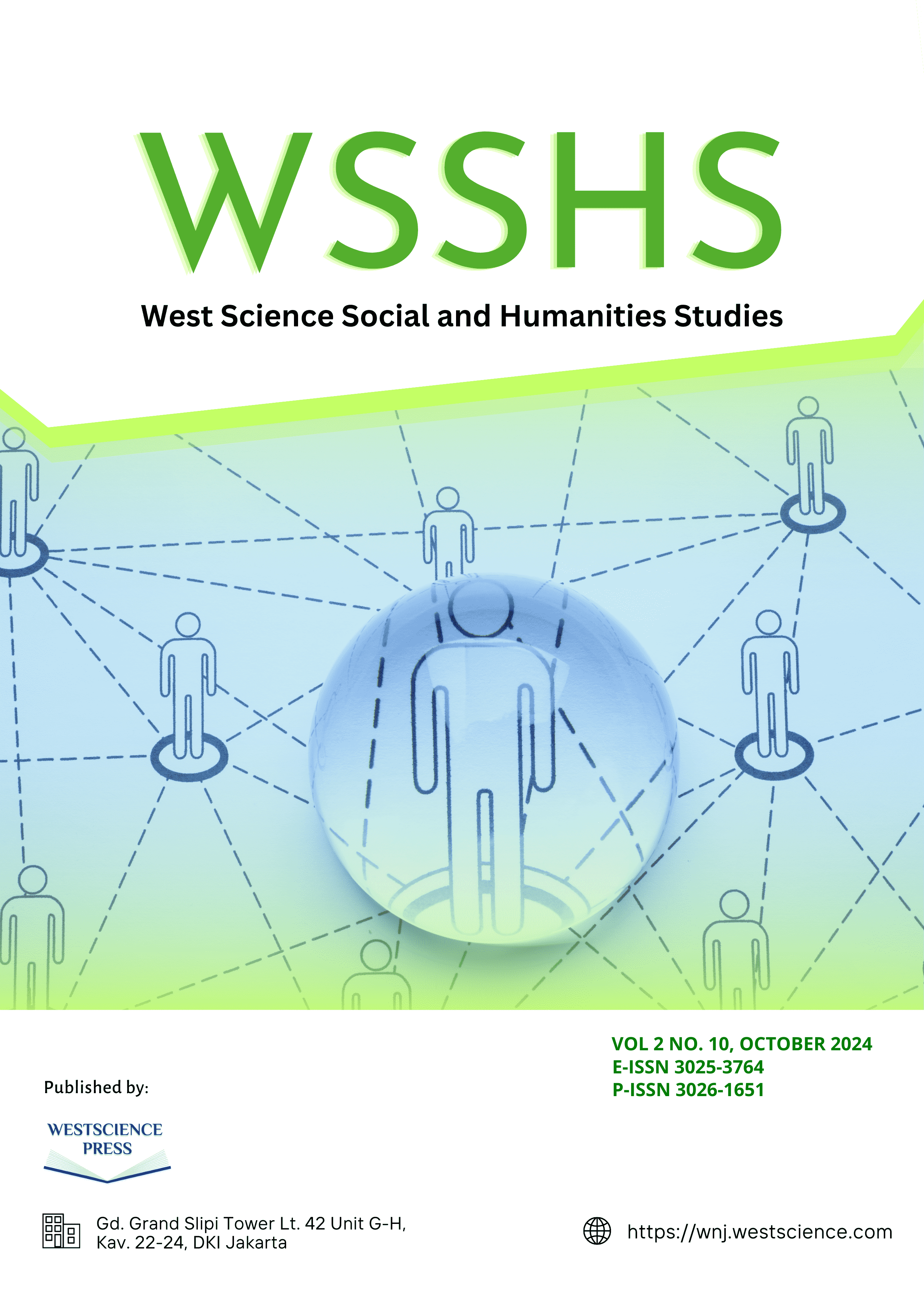Analysis of Regulatory Quality, Interagency Coordination, and Institutional Capacity on the Effectiveness of Public Services in Jakarta
DOI:
https://doi.org/10.58812/wsshs.v2i10.1345Keywords:
Regulatory Quality, Interagency Coordination, Institutional Capacity, Public Service Effectiveness, Jakarta GovernanceAbstract
This study examines the impact of regulatory quality, interagency coordination, and institutional capacity on the effectiveness of public services in Jakarta. Using a quantitative approach, data were collected from 100 respondents working in Jakarta’s public service sector. A Likert scale (1-5) questionnaire was employed to measure perceptions of the governance factors and service effectiveness, and the data were analyzed using Structural Equation Modeling-Partial Least Squares (SEM-PLS 3). The results reveal that all three governance factors—regulatory quality, interagency coordination, and institutional capacity—significantly and positively affect public service effectiveness, with institutional capacity having the strongest influence. The findings highlight the importance of governance reforms aimed at improving regulatory frameworks, enhancing interagency collaboration, and strengthening institutional capacity to ensure efficient public service delivery in Jakarta. This research provides key insights for policymakers to optimize governance systems for better public sector performance.
References
D. Ishak, “Public Services to Achieve Good Governance in Indonesia,” J. Abdimas Perad., vol. 3, no. 1, pp. 18–25, 2022.
I. Indriastuti, “Memahami Kembali Pelayanan Publik untuk Mewujudkan Tata Pemerintahan yang Baik (Good Governance),” Governance, JKMP (Governance, J. Kebijak. Manaj. Publik), vol. 10, no. 1, pp. 60–75, 2020.
Г. К. Исакова, “Анализ критериев и методов оценивания эффективности государственной службы,” Экономика и предпринимательство, no. 8, p. 1331, 2021.
M. Munjirin, “Redesigning The Organization Of The Jakarta City Government: Adaptation And Innovation Towards A Sustainable City,” Eduvest-Journal Univers. Stud., vol. 4, no. 3, pp. 1021–1032, 2024.
B. F. Setiawan, V. K. S. Rizal, and W. Mahendra, “Strategi Kebijakan Pemerintah Provinsi DKI Jakarta dalam Menanggulangi Tantangan Transportasi Perkotaan,” JOPPAS J. Public Policy Adm. Silampari, vol. 5, no. 2, pp. 145–156, 2024.
L. Judijanto, T. Taufiqurokhman, S. A. Hendrawan, and H. Herwanto, “Strategies for Utilizing AI and Data Analytics to Improve the Effectiveness of Public Services in Indonesia: A Local Government Level Approach,” West Sci. Bus. Manag., vol. 1, no. 05, pp. 412–419, 2023.
I. W. K. Suryawan et al., “Smart urbanism, citizen-centric approaches and integrated environmental services in transit-oriented development in Jakarta, Indonesia,” Res. Glob., vol. 8, p. 100181, 2024.
H. Wiguna, R. Manjali, and Y. Nugraha, “Harnessing digital government for place-based innovation policy: insights from Jakarta,” in Proceedings of the 16th International Conference on Theory and Practice of Electronic Governance, 2023, pp. 420–423.
L. Judijanto, T. S. Basri, A. S. Yahya, and K. Hasibuan, “Analysis of the Impact of Regulatory Change, Law Enforcement Effectiveness, and Bureaucratic Accountability on Public Service Quality,” West Sci. Law Hum. Rights, vol. 2, no. 01, pp. 53–61, 2024.
D. J. Timothy and L. G. Tahan, Archaeology and tourism: Touring the past, vol. 55. Channel View Publications, 2020.
A. Costantiello and A. Leogrande, “The regulatory quality in the light of environmental, social and governance framework at world level,” Discov. Glob. Soc., vol. 2, no. 1, p. 1, 2024.
I. Kosach, K. Shaposhnykov, A. Chub, I. Yakushko, D. Kotelevets, and O. Lozychenko, “Regulatory policy in the context of effective public governance: evidence of Eastern European Countries.,” Cuest. Políticas, vol. 40, no. 72, 2022.
M. V. Mendieta and Á. I. Alonso, “Developments in transparency in the Spanish municipalities: An analytical revision of the last research.,” Lex Localis-Journal Local Self-Government, vol. 15, no. 3, 2017.
L. Som and F. Naru, “Regulatory policy in India: Moving towards regulatory governance,” 2017.
G. Gereffi, “Academic foreword,” Reg. Stud. Policy Impact Books, vol. 4, no. 2, pp. 1–2, 2022.
P. Warmington et al., “Interagency Collaboration: a review of the literature,” Bath Learn. Interag. Work. Proj., 2004.
A. Gautam, “Role of Coordination in Effective Public Service Delivery System,” J. Public Adm. Gov., vol. 10, no. 3, pp. 158–201, 2020.
S. Vangen, K. Potter, and C. Jacklin-Jarvis, “Collaboration and the governance of public services delivery,” 2017.
L. Costumato, “Collaboration among public organizations: a systematic literature review on determinants of interinstitutional performance,” Int. J. Public Sect. Manag., vol. 34, no. 3, pp. 247–273, 2021.
R. Khan and F. Hussain, “Assessing policy capacity and policy effectiveness: A comparative study using sustainable governance indicators,” Eur. Policy Anal..
A. F. Firzada, B. Akbar, M. Ilham, and M. W. Kawuryan, “Impact Analysis of the Influence of Institutional Capacity and the Use of Performance-Based Budgeting on Original Regional Revenue Receipts in the Tanggerang Regency Area,” PERSPEKTIF, vol. 13, no. 2, pp. 552–559, 2024.
M. Rahman et al., “Institutional capacity assessment in the lens of implementation research: Capacity of the local institutions in delivering WASH services at Cox’s Bazar district, Bangladesh,” PLoS One, vol. 19, no. 2, p. e0297000, 2024.
F. Parinusa, D. Veronica, S. H. Idrus, E. Christianingsih, and R. Nokeo, “The Effectiveness of Digital Government Services, Public Participation Mechanisms, and Policy Innovation in Public Administration,” J. Acad. Sci., vol. 1, no. 3, pp. 146–151, 2024.
J. Mannayong, “Evaluation Of The Effectiveness Of Digital-Based Public Services In Makassar City,” Int. J. Econ. Manag. Res., vol. 3, no. 2, pp. 147–165, 2024.
B. D. Rogers and C. M. Lipsey, “Metropolitan reform: Citizen evaluations of performances in Nashville-Davidson county, Tennessee,” Publius, vol. 4, no. 4, pp. 19–34, 1974.
S. Kim, E. Rho, and Y. X. J. Teo, “Citizen Satisfaction Research in Public Administration: A Systematic Literature Review and Future Research Agenda,” Am. Rev. Public Adm., p. 02750740241237477, 2024.
T. Wallin Andreassen, “(Dis) satisfaction with public services: the case of publictransportation,” J. Serv. Mark., vol. 9, no. 5, pp. 30–41, 1995.
P. Sydelko, “A systemic integration approach to designing interagency responses to wicked problems,” in Proceedings of the 61st Annual Meeting of the ISSS-2017 Vienna, Austria, 2017.
О. Зубчик, С. Легкий, and І. Ткаченко, “INSTITUTIONAL CAPACITY, SOCIAL ENTREPRENEURSHIP AND NEW PUBLIC ADMINISTRATION: A COMPARATIVE ANALYSIS OF PUBLIC SERVICE DELIVERY IN DIFFERENT COUNTRIES AND REGIONS,” Наукові перспективи (Naukovì Perspekt., no. 1 (43), 2024.
O. Bashtannyk, “INSTITUTIAL CAPACITY OF THE UKRAINIAN PARLIAMENT IN THE CONDITIONS OF MODERN SECURITY THREATS,” Sci. J. Pol. Univ., vol. 63, no. 2, pp. 119–128, 2024.
Downloads
Published
Issue
Section
License
Copyright (c) 2024 Loso Judijanto, Moh Gifari Sono, Wahyudin Wahyudin

This work is licensed under a Creative Commons Attribution-ShareAlike 4.0 International License.




















 Instagram
Instagram 